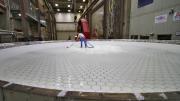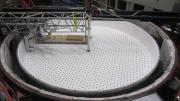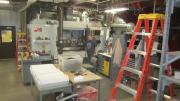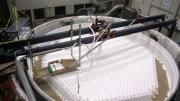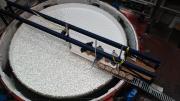In Tucson's late summer heat, under the steeply raked eastern stands of the University of Arizona Stadium (“Home of the Wildcats”), technicians at the Steward Observatory Mirror Lab this past weekend cast the third enormous mirror for the Giant Magellan Telescope (GMT), planned to be the world's largest and scheduled for partial operation by decade’s end. Although the telescope is designed to have six 8.4-meter (27.5-foot) asymmetrical mirrors ringing a seventh, central mirror once in full operation, astronomers from Harvard and a worldwide consortium of partner institutions will be able to begin observations as soon as the end of the decade, when four mirrors will be in place. (For a full account of the GMT project’s development and scientific potential, see “Seeing Stars” from Harvard Magazine.)
The Steward Observatory Mirror Lab (SOML) has pioneered the technology of casting specially engineered glass in enormous rotating kilns, shaping the mirror blanks so that grinding and polishing to meet optical specifications required for astronomical science—for the GMT, to tolerances of 20 to 25 nanometers, about one-twentieth of a wavelength of green light—can be minimized. The mirror blanks are shaped atop exactly contoured hexagonal columns of refractory material. That results in blanks that, when cooled and cleaned, have a honeycomb back surface: strong, stable, far lighter than solid glass, and able to be brought quickly to the ambient air temperature each night when astronomers use the telescope. (SOML maintains excellent online resources that describe the mirror-making processes, and the preparations for casting the third mirror this past weekend.)
As shown in the photo gallery here, the hexagonal blocks of refractory material are fabricated and assembled in the rotary kiln. It is loaded with about 20 tons of chunks of low-expansion borosilicate glass designed for chemical, mechanical, and thermal stability. The kiln is closed and heated to 1,170 degrees C (2,140 degrees F), and then rotated at six revolutions per minute to shape the molten glass into a parabolic shape before gradual cooling. Cleaning, grinding, polishing, and optical testing of the third mirror will take the next couple of years. Completing the first mirror—proving that an asymmetrical mirror of this size could be polished to the proper specifications—took seven years, beginning from casting in 2005. The second mirror was cast in early 2012, and the Giant Magellan organization has ordered glass for the fourth blank. Construction of the telescope structure, at the Las Campanas Observatory in the dry, Andean foothills of northern Chile—one of the world’s best sites for unperturbed, unobstructed observing—is scheduled to begin next year.
In a statement announcing the third mirror casting, Peter Strittmatter, of the Steward Observatory at the University of Arizona, said, “Astronomical discovery has always been paced by the power of available telescopes and imaging technology. The GMT allows another major step forward in both sensitivity and image sharpness. In fact, the GMT will be able to acquire images 10 times sharper than the Hubble Space Telescope and will provide a powerful complement not only to NASA’s [planned] 6.5-meter James Webb Space Telescope (JWST) but also to the Atacama Large Millimeter Array (ALMA) and the Large Synoptic Survey Telescope (LSST), both located in the southern hemisphere,” thus providing astronomers a comprehensive array of tools to observe and measure the same areas in space.
Update, August 29, 2013: The University of Arizona has posted a video on the casting, cooling (for six months), and polishing of the GMT's mirrors, including the third mirror, cast on August 24.
